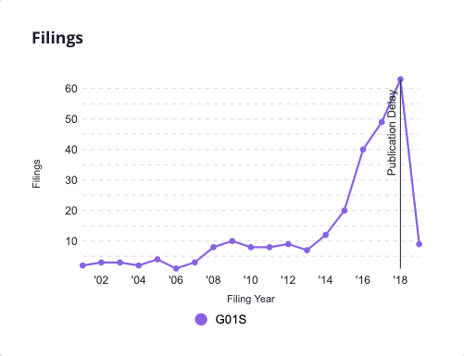To maintain successful business partnerships, law firms need to regularly assess new ways to benefit their IP clients. By putting in the effort to expand client relationships, firms can better demonstrate the value of their ongoing service.
Have you ever found your firm in these situations?- Your patent team has expertise in a specific technology area, but your client isn't sending that work your way.
- Your client is developing technology in new areas and has yet to consider your firm for that work.
Here are some strategies that will help you uncover opportunities to expand your current business relationships.
1. Make sure to keep your search narrow and relevant.
Limit your search in ways that demonstrate attention to detail and genuine care for your client's work. A narrow, relevant search -- rather than looking at the whole USPTO dataset, or your client's entire portfolio, or all your work with them -- will make for more compelling discoveries.For example, when comparing your success rate to another firm, make sure to look primarily at recent performance metrics. Fluctuating USPTO trends and new Supreme Court decisions can affect the performance of all firms. You may want to zero in on the most recent years of disposed applications to make sure everyone is on equal footing in your comparison. This ensures the most accurate representation of your firm's abilities.
By taking the time to consider your client's perspective, answering their questions before they have a chance to ask, you demonstrate respect for their work and dedication to their success.
2. Identify tech areas where your firm has lost ground to other firms.
With analytics from Juristat, your team can quickly identify which USPC/CPC classes are client priorities, and what percentage of those applications are sent to your firm. For the classes that appear most often, take a look at the number of applications your firm has prosecuted year-by-year. Are you noticing a downward trend?
To petition for more business, you should look at your firm's allowance rate for the company's applications within this class, your firm's allowance rate for this class overall, and similar numbers for competitor firms who have received a larger share of these applications from your client. If your firm is more successful than your competitors, your pitch for more business will be a slam dunk! All companies rely on patent prosecution success to develop their IP portfolio, and you just proved the value of your firm with insightful data.
Competitive intelligence data, like this sample from Juristat, can help prove that your firm is a better fit for your client.
3. Discover where your company is focusing its R&D initiatives.
The best companies are always exploring new revenue opportunities, and a robust R&D operation can lead to innovation outside of your client's usual specialties. Now is the time to see what types of new technology are on your client's radar, and follow up with another pitch that shows why your firm is the best to handle these prosecutions.
By sorting through your client's applications year-by-year, you can identify tech centers and CPC/USPC classes that pop up more regularly in application filings. It's fair to assume that classes with the highest increase in patent filings represent a new priority for your client.
 Although this assignee files a small number of patents in G01S, the recent spike in new filings shows where they're investing resources.
Although this assignee files a small number of patents in G01S, the recent spike in new filings shows where they're investing resources.
Limit your search to those classes, and do your typical comparison work. Which firms are receiving most of these applications, and how high is their allowance rate? Does your firm have a better track record with this type of technology? Narrow your search to applications in the past few years since this is a new company priority. The more focused your search, the more compelling your numbers, and your client will appreciate the extra consideration.
4. Demonstrate your current ROI - and make a case for future work.
With a little time and effort, your team can assure any client that your services provide a substantial benefit to their profit (especially if they are considering bringing patent prosecution in-house or exploring other firms).By using prosecution data to quantify ROI, you can communicate the specific dollar value of your work. Highlight your average number of office actions to allowance to show how your services save time and money. By putting more work into the competitor comparisons mentioned in #2, you can calculate how much your client’s patent portfolio would increase if your firm did the work of another, less successful firm. While a long-standing relationship gives you an advantage in new business negotiations, these metrics will bring your pitch home.
5. Be a proactive legal partner.
By actively looking for opportunities that benefit your client, you are setting your firm up as a go-to partner in their success. Here are some simple gestures that clients will take as an indication of your hard work and dedication to their profit:- Set up saved searches to monitor applications, especially those important to your client. They will appreciate the regular updates.
- Stay on top of prosecution deadlines. Protecting your client from any unnecessary fees will develop long-term trust.
- Identify new opportunities for licensing and acquisition. With Juristat 102 Forward Citation Alerts, you'll know each time an examiner forward cites an issued patent or patent application against competitors in 102 rejections. Identifying these frequently cited applications will help clients uncover potentially valuable licensing partnerships.
- Review new USPTO programs to determine where it may be the best fit for your client. It may take additional work (though it’s easy with Juristat), but it will foster trust with your client in the long-term.
When working with a long-standing client, don't be complacent and rely on past successes. By taking a dynamic approach to each client relationship, continually reevaluating their needs (whether stated or not), you can ensure a healthy and mutually beneficial partnership. By keeping an eye on their upcoming business development initiatives, you'll prove your firm to be indispensable to their IP development.
Do you want to evaluate new business opportunities with a current client? We can help.
(gradient).webp)


